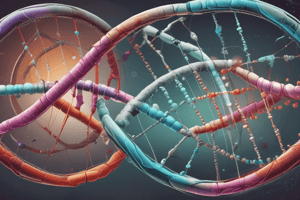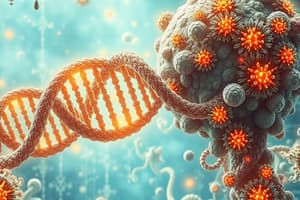Podcast
Questions and Answers
What are the three main functions of DNA?
What are the three main functions of DNA?
To store information, to replicate faithfully (preserve information), to have the ability to mutate (to add variability to information).
How do these three functions of DNA relate to its physical structure?
How do these three functions of DNA relate to its physical structure?
TBD
How are DNA sequences related to DNA information content?
How are DNA sequences related to DNA information content?
TBD
Why do we need mutations?
Why do we need mutations?
How does DNA store information?
How does DNA store information?
What type of information does DNA carry?
What type of information does DNA carry?
What is the coding sequence?
What is the coding sequence?
What are regulatory sequences?
What are regulatory sequences?
How do we preserve DNA information?
How do we preserve DNA information?
Outline gene expression.
Outline gene expression.
Describe dsDNA.
Describe dsDNA.
What does replicating faithfully mean?
What does replicating faithfully mean?
What makes DNA semi-conservative?
What makes DNA semi-conservative?
Who proved the semi-conservative theory for DNA?
Who proved the semi-conservative theory for DNA?
What were the three theories of DNA replication?
What were the three theories of DNA replication?
What is the semiconservative theory?
What is the semiconservative theory?
What is the conservative theory?
What is the conservative theory?
What is the dispersive theory?
What is the dispersive theory?
How did Meselson and Stahl prove the semi-conservative theory?
How did Meselson and Stahl prove the semi-conservative theory?
Why did Meselson and Stahl use nitrogen tags?
Why did Meselson and Stahl use nitrogen tags?
Describe semi-conservative replication.
Describe semi-conservative replication.
What happens if there is a mutation in one of the parental strands?
What happens if there is a mutation in one of the parental strands?
What is the third function of DNA?
What is the third function of DNA?
What do mutations do?
What do mutations do?
Define colinearity in regards to mutations.
Define colinearity in regards to mutations.
What is a silent mutation?
What is a silent mutation?
What is a mis-sense mutation?
What is a mis-sense mutation?
What is a nonsense mutation?
What is a nonsense mutation?
What happens if a mutation occurs in the regulatory sequence?
What happens if a mutation occurs in the regulatory sequence?
What happens when you have mutations and natural selection?
What happens when you have mutations and natural selection?
What is a knockout mutation?
What is a knockout mutation?
Flashcards are hidden until you start studying
Study Notes
Functions of DNA
- Main functions include: storing information, faithfully replicating for information preservation, and enabling mutations to increase variability.
Importance of Mutation
- Mutations provide genetic variability essential for adaptation and survival against pathogens and diseases.
DNA Information Storage
- Information is conveyed through the sequence of nucleotide bases.
- A gene encompasses the entire DNA sequence needed to produce functional proteins or RNA.
Content of DNA
- Carries information that codes for proteins and various types of RNA including regulatory signals.
- The coding and regulatory sequences are both crucial for proper gene function.
Gene Expression Process
- Begins with double-stranded DNA (dsDNA) synthesis, followed by RNA synthesis (transcription) to produce mRNA from the template strand.
- The other strand is the coding strand, resembling mRNA, which is then translated to synthesize proteins.
Structure of dsDNA
- Characterized by a double helix structure with strands that run antiparallel and are complementary.
- Contains a minor and major groove, with a diameter of 2.0 nm, 10 base pairs per helical turn, and each turn measuring 3.4 nm.
Semi-conservative Replication
- During replication, each parental strand serves as a template for a new daughter strand, ensuring the preservation of genetic information.
- Maintains one old strand with one new strand in each daughter duplex.
Evidence for Semi-conservative Theory
- Meselson and Stahl conducted experiments using nitrogen isotopes to demonstrate that DNA replication is semi-conservative.
- Their results showed the presence of hybrid DNA strands indicating old and new DNA combinations.
Implications of Mutations
- One strand’s mutation affects only one daughter strand; thus, the two new duplexes can differ, potentially leading to cell death if the mutation is severe.
- Mutations can alter protein products or have no effect at all, as seen in silent mutations, where the amino acid remains unchanged.
Types of Mutations
- Silent Mutation: No effect on protein product; same amino acid produced despite the base change.
- Mis-sense Mutation: Results in a different amino acid, altering the protein structure.
- Nonsense Mutation: Introduces a premature stop codon, terminating protein synthesis early.
Effects of Regulatory Sequence Mutations
- Can lead to excessive or insufficient transcription of genes, affecting protein levels.
Role of Mutations in Evolution
- Mutations, combined with natural selection, drive evolution by favoring advantageous alleles that improve survival, leading to increased prevalence in the population.
Knockout Mutation
- Causes a gene to be non-functional, resulting in the absence of the associated protein.
Studying That Suits You
Use AI to generate personalized quizzes and flashcards to suit your learning preferences.




